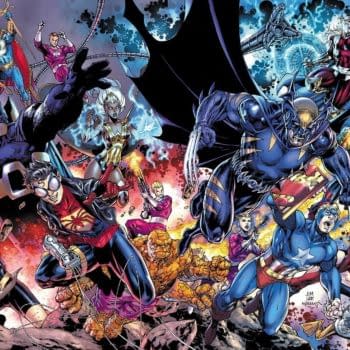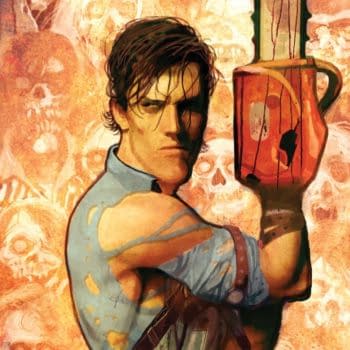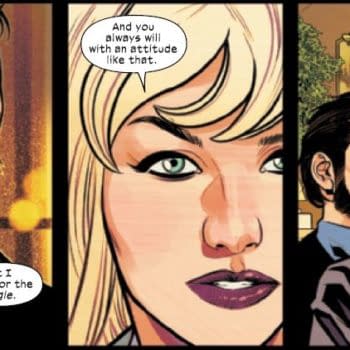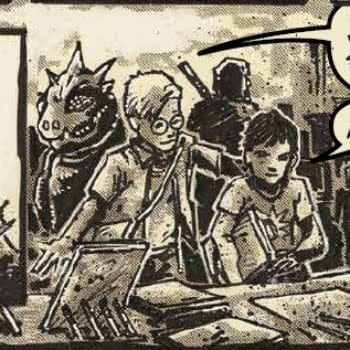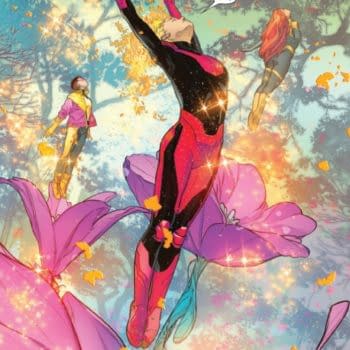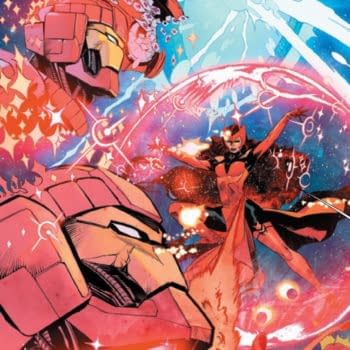Posted in: Comics, Recent Updates | Tagged: dark horse, entertainment, Hellbreak, howard the duck, image comics, Marvel Comics, oni press, rebels, Surface
Thor's Comic Review Column – Advance Review: Rebels #1, Surface #1, Hellbreak #1, Howard The Duck #1
This Week's Reviews:
Rebels #1
Surface #1
Hellbreak #1
Howard the Duck #1
Advance Review: Rebels #1 (Dark Horse, releasing April 8th)
By Bart Bishop

Although the main action of the story is in 1775, with the setting of the New Hampshire Grants, it starts with a bit of back story seven years prior. The main character, Seth Abbott, is brought up in a simple frontier life with a distant father until the day they attack a group of British soldiers. His father coaches him how to shoot, and although eight years spent fighting Albany and the soldiers of the New York regiments proves fruitless, Seth grows up a well respected man with a simple but noble set of morals. The present for Seth sees the supporting cast introduced, including his best friend Ezekiel who was a former runner for the red coats, and Mercy Tucker whom will soon be Seth's wife. The story is deliberately set away from the big players of the war, pointing out the distance in years from the Boston Massacre and Tea Party, and those gathered in Philadelphia. Although these self-proclaimed simple farmers only want their land back after rents came due early, they find themselves violently ambushed and forced to fight back. Consequently, Seth speaks out against the British forces, catching the attention of the historic patriot Ethan Allen.
I'm a long-time fan of Wood, having followed him since the days of Channel Zero all the way up through DMZ. I can't say I'm familiar with his more recent stuff which, with Conan and X-Men, has veered a bit more into the mainstream. That's not a judgment, and he's even commented on having put his time in, but it's nice to see him back in the unorthodox. That said, this is still a departure for him even if it has a thematic connection to rejection unjust dominance. His characters really shine through in the dialogue and their actions, with Seth as a well-rounded character that doesn't speak often, not unlike his father, but has a softer bit of poetry in his soul. This is especially apparent in his love of his friend Ezekiel, whom he considers a brother (and I suspect, not unlike a cop with one week until retirement, is going to reach a bad end) and how Mercy is a strong and fierce woman, even considering the time period. There's also a respectable sense of authenticity, which is vital in historical fiction like this, and important since it feels like Wood is trying to remind Americans of what we use to be while not straying from any dark underbelly.
That underbelly shines through in the violence that is so well rendered by Mutti. I'm not familiar with his work but this has left a strong first impression. There's a sense of realism without being photorealistic, with every panel seeming to overflow with detail and grit. Yes, this is a dirty comic book, as the majority of the characters probably haven't bathed in months if not ever. That grit shines through when it comes to the turning point moment when the British troops open fire on the protesting farmers. Their limp bodies are torn asunder, and I'm reminded of that popular 1990s movie The Patriot in its striving to show how these earlier wars weren't gentlemanly or noble, for all of our propping them up in legend. The difference is that while The Patriot veered a bit too far into pulp and evolved into an over-the-top action film by the end, this is grounded in a pure sense of the conventional meeting the apocryphal, revealing the harsh truth somewhere in between.
Certainly a strong start, this slice-of-life series offers insight into bygone era that is even more relevant in a time when the average citizen has lost trust for those in uniform.
Editor and teacher by day, comic book enthusiast by night, Bart has a background in journalism and is not afraid to use it. His first loves were movies and comic books, and although he grew up a Marvel Zombie he's been known to read another company or two. Married and with a newborn baby girl, he sure hopes this whole writing thing makes him independently wealthy someday. Bart can be reached at bishop@mcwoodpub.com.
Surface #1 (Image, $3.50)
By Cat Taylor
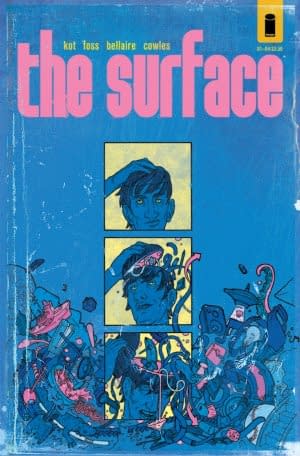
Being previously familiar with the work of both Warren Ellis and Grant Morrison, it was a lot easier for me to take a shot at their latest Image titles than it was for me to take a chance on Ales Kot. However, my lack of knowledge regarding Kot is due to my own ignorance. Kot has become near legendary as a comics writer and has been favorably compared to heavyweights such as the aforementioned Ellis and Morrison. As for my first impression, Kot does manage to reflect similar complexities of plot and the general weirdness that can be found in the works of Ellis and Morrison, but I'm going to need to read more issues of Surface to figure out if I like what he is doing or not.
The basic premise of Surface, is one of a future where every paranoid government conspiracy theory that dominates the polarized arguments of today is happening in a greatly expanded way. It's also a future where the social desire to constantly be connected online and to share every detail of one's life has also blown up into extreme proportions. In the middle of all this, the main characters are trying to discover whether or not rumors that the entire world is a hologram are true.
In order to set up this world, Kot includes an overwhelming amount of information in this first issue. It also seems that the creators want this comic to be equal parts social satire and political commentary. At times, I found myself questioning whether Kot is mocking the paranoia that this is what society could become or if he sees a lot of these ideas as realistic possibilities.
Much of the effectiveness of this comic is shared through the artwork of Langdon Foss. Foss is a well established and talented artist who has a knack for drawing characters with realistic and individual appearances in the middle of crazy, psychedelic settings. Although Foss's art is some of the most captivating work I've seen in the comic book format, it is also highly reminiscent of Frank Quitely. So, while its pretty fantastic, it loses points in the originality department. Despite that nit-pick, Foss is an excellent choice to illustrate this story. Not only does he have the psychedelic futuristic vision down, but he also illustrates a lot of the story as if it were being conveyed in a world where everyone is hyper-connected and constantly online. Some of his pages are absolutely exhausting but that's precisely the future environment in which this story is set; constant information all the time that is completely inescapable. When he portrays this, it looks like a webpage has blown up and surrounded us, complete with banner ads, scrolling text, audio, visuals, and tabs that can be clicked for even more information.
While I'm on the subject of the art, Surface is also one of those comics where the efforts of the colorist stand out. In a presumed attempt to match the dissonance portrayed in the illustrations, Jordie Bellaire colors the work using hues that seem to only be found in the large Crayola box of 64 crayons. If you're a big fan of the primary color wheel, you'll have to search elsewhere for your visual fix.
Any story this complex is impossible to completely rate after only a single issue but one thing I can say for sure is that this is no ordinary comic book. I'm also pretty confident that Surface will at least attract a rabid cult following. The possible peril I see is that with a premise like this, the writer could easily fall into smug, pretentious territory where he gets so caught up in the weirdness and/or political commentary that he stops caring about telling a good story. Then again, some readers may prefer that approach. For me, however, I'm hoping that future issues of Surface turn it into one of those rare comics that blow my mind.
Cat Taylor has been reading comics since the 1970s. Some of his favorite writers are Alan Moore, Neil Gaiman, Peter Bagge, and Kurt Busiek. Prior to writing about comics, Taylor performed in punk rock bands and on the outlaw professional wrestling circuit. During that time he also wrote for music and pro wrestling fanzines. Guess how many fingers I'm holding up. You can e-mail Cat at cizattaylor@hotmail.com.
Hellbreak #1 (Oni Press, $1)
By Graig Kent
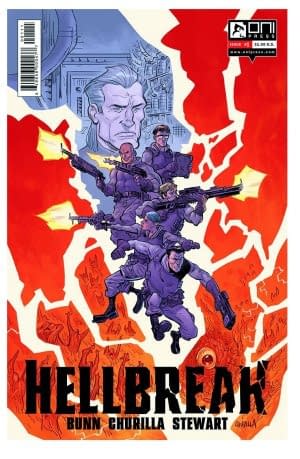
The point here is there's a very strong, malleable group of ideas at the heart of this that could service multiple story formats. Like any good idea, the ones here lead to a lot of interesting questions to be asked about them. Questions, in turn, lead to story ideas and any many intriguing possibilities.
Hellbreak is an ongoing (one which Churilla is apparently many, many issues deep into illustrating), so I expect a more episodic vantage point is in play. The concept finds the Kerberos Institute led by the mysterious (his cagey wordplay gives away his secretiveness) Marik Proctor working in association with the Catholic church. His group has not only validated that there are an infinite number of hells where one could wind up (after death or as a result of demonic possession, or perhaps for other reasons) but also discovered a means to travel to those hells. It would appear the institute will help out with demonic possession cases (its as yet unclear if this is a "for-profit" organization), sending in the black ops "Orpheus Team" to the relevant plane of hell to recover the lost soul, while in the land of the living the Institute attempts to extract the demon from its host. As Proctor states, they have about a 50% success rate overall.
The concept would fit well as weekly television, but I suspect that instead of being done-in-one each issue that subsequent adventures will be doled out in four or five-chapter arcs for easy trade collecting. Bunn and Churilla would be wise to vary each mission in issue length, one adventure could take five issues where the next one could take only two, just to mask the formula and toy with expectations. With this first issue there's no apparent over-arching threads that speak to a big ultimate plan, nothing hinting at, say, a nefariousness to Proctor or the Institue, or any major player in the demonic possession game that needs to be addressed. The only hint of anything bigger lay with one of the Orpheus Team members who potentially lost a wife and/or child and may seek to use the Kerberos technology to rescue them (there's also no clear delineation as yet whether the Institute will only help recovers the souls of the possessed and not those who have actually died).
Bunn, as always, doles out a thoughtful script. It's not a deep interrogation of the conceits in play, nor does it provide much depth of character, but it sets an intriguing foundation for providing a lot of fun and excitement (and horrors) going forward. I've read the bulk of Churilla's output and this is hands-down the best he's looked. He started working with a new technique, going fully digital for this series, using a custom brush and the effect is tremendous. While still his own framework of blocky, expressive caricatures, the accentuation lines and texture here provide a hint of Guy Davis or Gary Gianni on top. The effect delivers some victorian goth amid the vibrant violence. As usual, Churilla excels at concocting weird, demented creatures, so a series jumping around an infinite number of hells should provide him a tremendous outlet for creating a multitude of such. Dave Stewart does some marvelous things with the colouring here, dropping out certain hues at times, or, in one sequence in particular, keeping it black and white with only the subtlest hints of colour. Yet, in the opening sequence, retelling the myth of Orpheus, goes for broke with the pallette. Stewart shies away from gradients, the flat colors work well with Churilla's more open style, hearkening back a bit to old EC horror books. For a buck, and 28 pages, Hellbreak is an easy sell.
Graig Kent writes things on the internet for no money. Sometimes he posts pictures of his dog for no money too.
Howard the Duck #1 (Marvel, $3.99)
By Jeb D

The Marvel Universe has always built itself around the outsider (The Hulk, Ben Grimm, numerous X-Individuals, etc.), but in his occasional appearances, Howard The Duck has always been the ultimate outsider. Though stories of the outcast in Fantastic Four or X-Men can work as metaphor, the typical Marvel "outsider" is still a gorgeously rendered young person of incredible power and physical beauty (the paradigm shift from Steve Ditko's Peter Parker to John Romita's is pretty definitive in that respect), not a powerless, curmudgeonly fowl.
Howard also sees himself as the only reasonable being in a world of irrational hairless apes, and reintroducing him for the first time since Ty Templeton's 2007 series, this might have posed an opportunity to use his perspective to join the current discussion on the challenges of societal norms and their effects on gender, ethnicity, culture… and species, I guess (after all, Howard was also once the star of an adults-only MAX title).
Doesn't seem to have been in the cards, though: for better or worse, what we get is an amusing, witty caper comic, with Howard as a feathered P.I., that ties in nicely with titles like Deadpool or Secret Avengers… or, of course, She-Hulk, where Howard made several of his crossover appearances back when Steve Gerber was still writing the character occasionally, and who leads the parade of guest stars in this issue. Should anyone have wondered if Chip (Sex Criminals) Zdarsky's scripting is as droll and idiosyncratic as his artwork, it's at least its equal, and it's largely due to the strength of his skewed perspective that Howard's debut is closer to a strong issue of Superior Foes of Spider-Man than to blander fare like Avengers A.I. or Infinity: Heist. He's not afraid of the occasional pisstake on Marvel's various icons: not many writers would try to mine laughs from seeing Spider-Man crumpled on the ground moaning "Oh, no, I'm sorry Uncle Ben" when he thinks Howard's been disintegrated, and his snarky riffing on the subject of Catwoman versus Black Cat is the kind of thing Gerber might have come up with.
Artist Joe Quinones tells the story clearly and cleanly, with minimal background and nice attention to facial expressions. I don't know how Quinones works, but I'm going to assume that it's a pretty linear front-to-back approach to the script; if so, then deadline pressures might be a reasonable explanation for the slightly rushed quality his work takes on for the second half of the book. It's a small difference, though, and his full-page parody of a rousing Rocky-like "training sequence" makes a highlight of what, in other hands, might have been a pretty tired joke.
It's a good time to be a fan of the slyer, more eccentric side of Marvel Comics: Howard's new series looks like it should fit just fine on the shelf beside Secret Avengers, She-Hulk, and Hawkeye.
Jeb D. figures his bracket's already busted. Sláinte!










